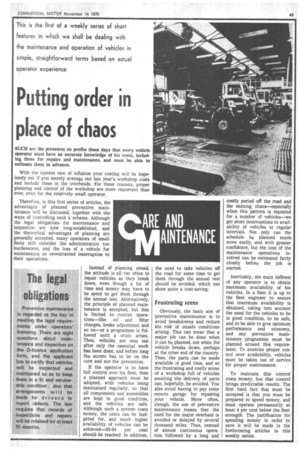ch E Al i slNANCE Instead of planning ahead, the attitude is all too
Page 45

If you've noticed an error in this article please click here to report it so we can fix it.
often to repair vehicles as they break down, even though a lot of time and money may have to be spent to get them through the annual test. Alternatively, the principle of planned maintenance is accepted, but this is limited to routine operations—like oil and filter changes, brake adjustment and so on—or a programme is followed until a crisis arises. Then, vehicles are sent out after only the essential work has been done, and before long the accent has to be on the cure and not the prevention.
If the operator is to have full control over his fleet, then a planned approach must be adopted, with vehicles being maintained regularly, so that all components and assemblies are kept in good condition, and the vehicles are safe. Although such a system costs money, the costs can be budgeted for, and much higher availability of vehicles can be achieved-93-4 per cent should. be reached. In addition, the need to take vehicles off the road for some time to get them through the annual test should be avoided, which can show quite a cost-saving.
Frustrating scene
Obviously, the •basic aim of preventive maintenance is to avoid breakdowns and reduce the risk of unsafe conditions arising. This can mean that a major job can be done when it can be planned, not when the vehicle breaks down, perhaps at the other end of the country. Then, the parts can be made available in good time, and so the frustrating and costly scene of a workshop full of vehicles awaiting the delivery of parts can, hopefully, be avoided. You also avoid having to pay some remote garage for repairing your vehicle. More often, though, the use of preventive maintenance means that the need for the major overhaul is avoided or delayed by several thousand miles. Thus, instead of almost continuous operation followed by a long and costly period off the road and the ensuing chaos—especially when this pattern is repeated for a number of vehicles—we get short interruptions to availability of vehicles at regular intervals. Not only can the schedule be planned much more easily, •and with greater confidence, but the cost of the maintenance operations involved can be estimated fairly closely before the job is started.
Inevitably, the main inedrest of any operator is to obtain maximum availability of his vehicles. In a fleet it is up to the fleet engineer to ensure that maximum availability is obtained, taking into account the need for the vehicles to be in good condition, to be safe, and to be able to give optimum performance and economy, and any preventive maintenance programme must be planned around this requirement. To exercise •proper control over availability, vehicles must be taken out of service for proper maintenance.
To maintain this control costs money, but that control brings predictable results. The first hard fact that must be accepted is that you must be prepared to spend money, and must operate permanently at least 4 per cent below the fleet strength. The justification for spending money in order to save it will be made in the forthcoming articles in this weekly series.




























































































































